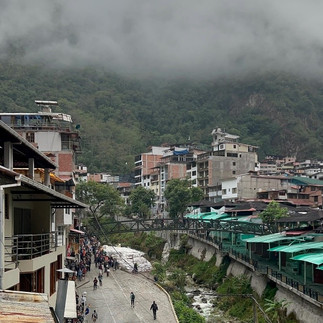Gariwerd Rock Art Management Forum at the International Institute of Conservation Congress in Peru!
- micko97
- Oct 9, 2024
- 6 min read
Monday – Friday | 21 September – 8 October 2024
Presenting our article on the Gariwerd Rock Art Management Forum at the International Institute of Conservation Congress & Connecting with First Nations communities at Machu Picchu (Peru) and Belo Horizonte (Brazil).
Following the successful Rock Art forum in March 23, representatives from the 4 partner organisations worked together throughout the next 18 months on a Practitioners Guide for Rock Art Management in Australia. Following this groups work, we were lucky enough to be invited to present at the the 2024 International Institute for Conservation Congress in Lima (Peru) in September.
IIC
The International Institute for Conservation of Historic and Artistic Works (IIC) and the Research Center for Heritage Conservation at the Universidad de Ingenieria & Tecnologia (UTEC) in Lima, are pleased that the 30th biennial IIC Congress 2024 will be hosted in person and online in Lima, Peru.
The Congress theme is 'Sustainable Solutions for Conservation: New Strategies for New Times'.
Arrival in South America
Leroy and I headed off on the 19th of September to Peru, via Santiago, Chile, arriving Thursday afternoon to settle in and have a couple of days to orientate ourselves and look around the local area.
IIC Congress
Following registration and welcome, the congress format was 1 hour blocks of presentations, followed by panel Q&A sessions over 5 days, with a few other talks and tour visits scheduled in.
Our group presented on Monday afternoon, with reps sharing sections of a slide show to talk for about 3 minutes each on. This was followed by a panel, featuring two reps from our group as well as a few online presenters also.
The conference concluded day 1 with an opening reception at the Museo de Arte Contemporáneo (MAC), featuring canapes, networking, and local dancers for entertainment.
Day 2
Tuesday was a chance to explore the Lima Main Square, known as the birthplace of Lima. The Square is bordered by some impressive historical buildings, one of which being the Catholic Cathedral and Catacombs (tombs) underneath, which we booked a tour of.
We then headed back to the conference to catch Andrew Thorn’s presentation on the positive role trees have in protecting rock art sites.
Day 3
Wednesday saw us off on the various technical tours in the area, with our group all choosing to visit Pachacamac, a sanctuary set up at one of the most important pilgrimage centres of the pre-Hispanic period, with occupancies dated back to 5,000 BC.After about an hour bus trip, Pachacamac started with a visit through the museum and guided tour through the archaeological ruins of the temple, Inka road and surrounds.While on route to the sanctuary, we spotted some eucalyptus trees and decided to explore if we could possibly conduct a smoking ceremony there as a way to connect to country, but more importantly to relieve any bad spirits or feelings after visiting the catholic cathedral and catacombs, which a majority of the tour groups were intrigued in and participated in as well.
Day 4
Back at UTEC on Thursday, we listened in on a few presentations based around adapting environments in museums, archives and storage, some of which we figured could be relevant to future planning at Brambuk plus our respective organisations in regard to artefact storage.
We then made the trek to Huaca Pucllana, which is a brick and clay pyramid located in Mira Flores that served as a ceremonial center for the Lima people between the years of 200 AD and 700 AD. The guided tour here was very informative and engaging, giving an overview of life for the Lima including ritualistic sacrifices, prayer and offering areas, burial tombs, food production and building supply/mud pits for building and repairs. After the downfall of the Lima people, the area went into ruins and was covered in sand, which was then used as a rubbish dump and motocross track, before being re-discovered in the early 1980’s, excavated and protected, and is still being excavated and uncovered today.
Thursday night also featured a visit to Chinatown and the Circuito Mágico Del Agua, or Magic Water Circuit, a fountain and light show in Lima.
Day 5
Friday we made our way to UTEC for the announcement of the Keck Award for 2024, a £2500 prize, awarded to an individual or group who has contributed most towards promoting public understanding and appreciation of the accomplishments in conservation. Out of 11 initiatives, we were over the moon to learn we made the honourable mention list, finishing up 2nd behind a street art protection project from Buenes Aires, Argentina!
Travel to Cusco
Friday night we also were booked in to head off to Cusco, a 90-minute flight from Lima.
Saturday in Cusco was filled with visits to markets, historical buildings, and streets as well as a visit to Tupac Amaru Plaza, named in honor of Tupac Amaru II, a revolutionary who led one of the biggest rebellions in Latin America in the 1700s. The plaza featured a large market with a big range of fresh and cooked foods, gifts, and clothing, and was also in close vicinity to the Cusco Football Stadium, where we decided to check out the local rivalry game being played between the two Cusco teams.
We then explored a bit more of Cusco to try and find a supermarket where we could stock up on supplies for our trip to Machu Picchu.
Machu Picchu
Sunday morning we were up bright and early at 5 am to catch taxis to the bus station, followed by a 2-hour bus trip to Ollantaytambo, followed by a 2 hour train trip to Aguas Calientes, also known as Machu Picchu Pueblo, which is the closest town to Machu Picchu. We dropped our things at the hotel and then queued up for the buses that take you to Machu Picchu. This queue was about 500m long and took around 2.5 hours to get to the front of as the buses only fit around 20-23 passengers at a time.
Once on the bus, it was a 25 minute trip up to Machu Picchu, where we queued again before gaining entry to the site, and it was here we met our guide named Felix, who was going to show us around. During the first portion of the tour Felix spoke about how the site would’ve been used back in the day and that it was home to around 2000 people in its peak. He then took us away from the main site to see some of the Inca trail, including some very impressive retaining walls and paths on the cliff edge, explaining on the way part of this trail joins the main Inca road system that extends from Chile in the south, to Colombia in the north, which was all hand paved. Felix also mentioned how the Incans would run the trail to deliver messages or goods between areas, sometimes running up to 100km per day. We then headed back towards a viewpoint above the main site where Felix spoke about everyday life at Machu Picchu, how they would grow crops on the mountaintops, how the society worked, and what the layout of the area was. We then made our way down among the ruins learning about the creation of the walls, rooms, and structures in the area, how they split and carved the stones, and how they moved these huge slabs to be placed with precision in walls and walkways. With the sun setting over the Andes to the west, we started to wrap up our tour and head back out where we were greeted with another huge queue for the buses back to Aguas Calientes. Felix waited with us while in the queue and also rode the same bus with us, making sure we found our way home as well as to a restaurant he suggested for dinner that night.
Heading home
The next morning we were faced with the return trip to Cusco, train-bus-taxi again in reverse order to the last time. When back at our accommodation, the rest of the group had to pack up in preparation for heading back to Lima, to then fly onto Belo Horizonte (Brazil), while myself and Billy Briggs were heading home to Aus via Santiago once again. (however he had a night alone back in Lima, and I had the same in Cusco, before we met in Santiago.)After a 10 hour wait at Satiago airport, we boarded for Melbourne, arriving at 4:00am Thursday morning!
What’s next
The next steps for this group to build on the experience in South America is to finalize and publish our Rock Art Practitioners Guide, which pulled on the information and knowledge shared at the forum in March 2023, and will be the first traditional owner-led initiative in this area. The guide is due to be released later in 2024.
Troy Lovett














































At Sadaat Electronics, discover a premium range of cooling and laundry solutions tailored for your home. Explore the latest Floor Standing Air Conditioner Price in Pakistan, competitive Air Conditioner Price in Pakistan, and reliable Washing Machine Price in Pakistan collections. Choose from Front Load Washing Machine Price in Pakistan, or Twin Tub Washing Machine Price in Pakistan models to suit your style and daily needs.
Discover the perfect cooling solution at Jet Cool, where innovation meets reliability. Explore our wide range, including the latest Double Door Refrigerator Price in Pakistan for spacious storage, sleek Single Door Refrigerator Price in Pakistan for compact needs, and elegant French Door Refrigerator Price in Pakistan for a premium kitchen upgrade. Choose Jetcool for smart refrigeration!
Experience modern living with Emirates Electronics, your one-stop destination for quality home appliances. From an advanced Food Factory Price in Pakistan and soothing Humidifier Price in Pakistan to a powerful Insect Killer Price in Pakistan, we’ve got you covered. Elevate your space with a premium Sound Bar Price in Pakistan and ensure hygiene with our efficient Hand Dryer Price in Pakistan—shop smart with Emirates!
At MASQ Electronics, redefine your indoor cooling with our powerful collection of floor standing air conditioners. From the sleek Midea Floor Standing to the energy-efficient Daikin Floor Standing and the reliable Acson Floor Standing, we deliver comfort, style, and performance for homes and businesses. Discover the difference with Masq Electronics today.
At Sohail Electronics, we offer premium home appliances designed for comfort and convenience. From the latest Samsung Refrigerator Price in Pakistan to efficient Air Conditioner Price in Pakistan, we’ve got it all. Discover stylish Refrigerator Price in Pakistan, modern Water Dispenser Price in Pakistan, and healthy cooking with our Air Fryer Price in Pakistan!